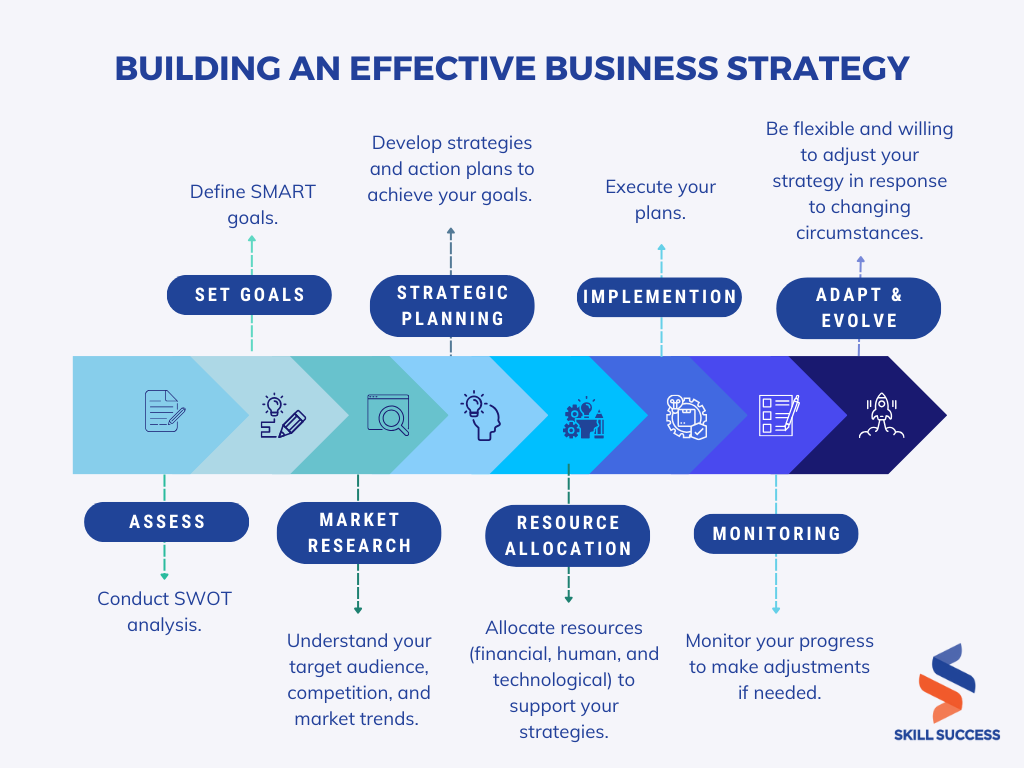Business strategies are constantly evolving, and what worked yesterday may not work tomorrow. As a business communication trainer for 15 years, I've seen firsthand how the business landscape has changed over time. That's why it's essential for businesses to stay ahead of the curve, continuously learn business skills, and adopt new strategies that will help them succeed in the ever-changing marketplace.
In this article, I'll share the best business strategies for 2024. These strategies are based on my own experience and research, and they're designed to help businesses of all sizes thrive in the coming year.
What is a Business Strategy?
A business strategy refers to the business’s high-level plan in attaining set objectives. It serves as guide for organizational decisions such as marketing strategies and hiring of employees. It consists of the specific actions and steps that a business must do to reach its goals.
The creation of business strategies requires thorough planning, consideration, and development. It involves all departments' participation across the company to ensure everyone is on the same page towards respective goals.
Business strategy serves as the blueprint for companies, guiding them towards achieving their long-term objectives. In an increasingly digital landscape, tools such as the online paper writer service play a crucial role, offering tailored solutions that can seamlessly integrate into a firm's broader strategic approach. This fusion of traditional planning and modern tools can be pivotal in navigating a dynamic marketplace.
The Importance of Having Business Strategies
I often tell my students the importance of having a well-thought-of business strategy. A business without a strategy is like a ship without a rudder: it's adrift and unlikely to reach its destination.
A good business strategy provides a roadmap for how a company will achieve its goals. It helps to align all aspects of the business, from marketing and sales to operations and finance. It also helps to ensure that the company is making sound decisions that will lead to long-term success.
-
Direction and Purpose: A well-crafted business strategy provides direction and purpose. It outlines the path an organization needs to take to reach its goals. Without a strategy, a business can easily lose its way, wandering aimlessly without a sense of purpose.
-
Effective Resource Allocation: Strategies enable efficient allocation of resources. They help in identifying which resources—be it time, money, or talent—need to be allocated to specific initiatives. This prevents wastage and ensures that resources are used effectively.
-
Competitive Edge: What is the unique thing that you bring to the table? In today's fiercely competitive business landscape, having a strategy is akin to having a competitive edge. For instance, a hotel may invest in hotel software as part of their strategy to improve customer service and make operations more efficient. It allows businesses to differentiate themselves from competitors, offering unique value propositions and staying ahead in the market.
-
Adaptation to Change: Business environments are subject to constant change. A well-structured strategy equips a company to adapt and evolve as circumstances shift. It provides a framework for making informed decisions in the face of uncertainty.
-
Alignment of Efforts: Strategies align the efforts of all team members. When everyone understands the overarching strategy, they can work cohesively toward common objectives. This alignment fosters teamwork and maximizes productivity.
-
Measurable Progress: Strategies come with measurable milestones and KPIs (Key Performance Indicators). They allow for tracking progress and evaluating the success of initiatives. This data-driven approach enables businesses to make informed adjustments as needed.
-
Risk Mitigation: By anticipating potential challenges and risks, a well-thought-out strategy helps in risk mitigation. It allows businesses to have contingency plans in place, reducing the impact of unforeseen events.
-
Customer-Centric Approach: Strategies often revolve around understanding and meeting customer needs. A customer-centric approach not only enhances customer satisfaction but also fosters brand loyalty and repeat business.
Examples of Business Strategies in 2024 (with Expert Insights)
Embrace AI and other new technologies
Artificial intelligence (AI) and other emerging technologies are transforming businesses of all sizes. AI can be used to automate tasks, improve efficiency, and gain new insights from data. Other new technologies, such as the blockchain and the Internet of Things (IoT), can also be used to create new products and services or improve existing ones.
Some examples of how businesses are using AI and other new technologies include:
- Using AI to automate customer service tasks: AI-powered chatbots can now answer customer questions and resolve issues 24/7. This can free up human customer service representatives to focus on more complex tasks.
- Using AI to improve product development: AI can be used to analyze customer data and identify trends and patterns. This information can then be used to develop new products and services that meet the needs of customers.
- Using AI to optimize marketing campaigns: AI can be used to target marketing campaigns to specific audiences and measure the effectiveness of those campaigns. This can help businesses to reach more customers and spend their marketing budget more wisely.
- Using blockchain technology to create new payment systems: Blockchain technology can be used to create new payment systems that are more secure and efficient than traditional systems.
- Using IoT technology to improve supply chain management: IoT sensors can be used to track the movement of goods through a supply chain. This can help businesses to identify and resolve problems more quickly and efficiently.
- Using social channels for diverse product offerings: Harness the power of social media platforms like Facebook, Instagram, and Discord to extend your product range. Engage with your audience, gather insights, and introduce new offerings that resonate with their preferences and needs.
- Using AI for website translation: AI-driven translation services, such as Centus, can automatically translate website content into multiple languages, helping businesses reach a global audience and tailor their message to diverse markets. This not only enhances accessibility but also improves user experience for non-English speaking visitors.
To enhance user engagement and satisfaction, we utilized AI technologies to personalize the user experience. By leveraging AI algorithms, we could recommend relevant biblical resources based on users' interests, reading habits, and search history. This personalized approach increased user retention and deepened their connection with the platform.
Embrace remote work and hybrid models
The way we work has fundamentally changed, and businesses that embrace remote work and hybrid models are reaping the benefits.
- Remote Work Technology: Invest in remote work technology that enables seamless collaboration and communication. Tools like virtual reality (VR) for virtual meetings and augmented reality (AR) for remote troubleshooting can enhance productivity and reduce geographical barriers. There are also project management software like monday.com and Asana that lets you assign tasks and share documents easily.
- Flexible Work Arrangements: Offer flexible work arrangements to attract and retain top talent. Remote work options and flexible hours can improve work-life balance and employee satisfaction. Opt for eCommerce business models: Simplify the process of running a business by choosing an eCommerce model such as dropshipping. An online business provides you with both flexible and remote work at the same time.
At OutsourcingStaff.ph, we've implemented these strategic planning tips and seen significant improvements. One particular success story is when we identified early in the pandemic that many businesses would need to shift to remote working. We adapted our strategy accordingly and began offering more comprehensive solutions for remote staffing. As a result, we were able to grow our client base significantly during a challenging period for businesses.
Focus on sustainability
Consumers are increasingly demanding sustainable products and services. Businesses that can demonstrate their commitment to sustainability are more likely to attract and retain customers.
Some ways that businesses can focus on sustainability include:
- Using renewable energy sources: Businesses can switch to renewable energy sources, such as solar and wind power, to reduce their carbon footprint.
- Reducing waste: Businesses can reduce waste by implementing recycling and composting programs.
- Using sustainable materials: Businesses can use sustainable materials, such as recycled paper and organic cotton, in their products and packaging.
- Offsetting carbon emissions: Businesses can offset their carbon emissions by planting trees or investing in renewable energy projects.
Provide a superior customer experience
Businesses that can create a positive customer experience are more likely to repeat customers and referrals.
- Being responsive to customer needs: Businesses should be responsive to customer needs and resolve issues quickly and efficiently. Using the right help-desk software to keep you connected to customers is very important here.
- Personalizing the customer experience: Businesses should personalize the customer experience by using data to understand individual customer needs and preferences.
- Making it easy for customers to do business with you: Businesses should make it easy for customers to do business with them by offering convenient shopping and payment options. This not only streamlines the shopping process but also adds substantial value to the overall customer shopping experience through a high-functioning online store.
Prioritize user-centric design to create visually appealing websites that offer exceptional user experiences. Diversify your services, such as content creation and mobile app development, to broaden your client base. Leverage data analytics and SEO tools to make informed decisions and showcase your expertise.
Invest in employee development
Employees are the most important asset of any business. Businesses that invest in employee development are more likely to have a productive and engaged workforce.
Some ways that businesses can invest in employee development include:
- Providing training and development opportunities: Businesses can provide employees with training and development opportunities to help them learn new skills and advance their careers.
- Creating a culture of learning and innovation: Businesses can create a culture of learning and innovation by encouraging employees to share ideas and experiment with new ways of doing things.
- Offering competitive salaries and benefits: Businesses can offer competitive salaries and benefits to attract and retain top talent.
Encourage a culture of continuous learning and adaptability within your organization. Be open to feedback, both internal and external, and use it to refine your strategy. Foster innovation and empower employees to suggest improvements and embrace change. By being agile and willing to pivot when necessary, your business can respond more effectively to unforeseen challenges and opportunities.
Harness the power of data analytics
In 2024, data is more valuable than ever, and businesses are leveraging advanced data analytics techniques to gain insights and make informed decisions.
- Customer behavior analysis: Use data analytics to analyze customer behavior patterns. Understand how your customers interact with your products or services, both online and offline. This knowledge can guide product improvements and marketing strategies.
- Predictive analytics: Employ predictive analytics to anticipate market trends and customer preferences. By analyzing historical data and using AI algorithms, you can make data-driven predictions, helping you stay one step ahead of your competitors.
- Operational efficiency: Optimize your business operations with data-driven insights. Identify bottlenecks, streamline processes, and allocate resources more efficiently. This can result in cost savings and improved productivity.
Expand your global footprint
In the interconnected world of 2024, businesses are expanding their global reach. Whether you're a small startup or an established corporation, consider these strategies:
- Market research: Conduct thorough market research to identify international opportunities. Leverage AI and data analytics to understand market trends and consumer behavior in different regions.
- Localized marketing: Customize your marketing strategies to cater to local preferences and cultural nuances. Tailor your messaging and advertising campaigns to resonate with diverse audiences.
- Global supply chain optimization: Optimize your global supply chain to ensure efficient distribution and delivery worldwide. Consider using blockchain technology to enhance transparency and traceability.
Steps to Building an Effective Business Strategy
1. Assess Your Current Situation
Analyze your strengths, weaknesses, opportunities, and threats (SWOT analysis). This will help you to understand your current situation and identify potential areas for improvement.
2. Set Clear Goals
Define specific, measurable, achievable, relevant, and time-bound (SMART) objectives. This will give you a clear understanding of what you want to achieve and how you will measure your progress.
3. Market Research
Understand your target audience, competition, and market trends. This will help you to develop strategies that are aligned with the needs of your customers and the competitive landscape.
4. Strategic Planning
Develop strategies and action plans to achieve your goals. Once you have a strategy in place, don't forget to utilize tools like receipt templates to streamline your business operations and ensure smooth financial management. This should include a clear understanding of the resources you will need and the timeline for implementation.
5. Resource Allocation
Allocate resources (financial, human, and technological) to support your strategies. This will ensure that you have the necessary resources to execute your plans and achieve your goals.
6. Implementation and Monitoring
Execute your plans and regularly monitor progress. This will help you to identify any potential problems early on and make adjustments as needed. I strongly recommend learning about project implementation and project monitoring.
7. Adapt and Evolve
Be flexible and willing to adjust your strategy in response to changing circumstances. The business world is constantly changing, so it is important to be able to adapt your strategy accordingly.

Recommended Courses
1. Master Your Business Analysis Skills
 Course Rating:
5/5
Course Rating:
5/5
"Master Your Business Analysis Skills" is designed to empower both professionals and aspiring analysts. It provides essential business analysis skills for career advancement. The course covers diverse roles and potential career paths in business analysis.
This course stands out by highlighting the versatile application of business analysis skills. It emphasizes practical use across various organizational functions. The content is both comprehensive and insightful.
I found the course to be an excellent introduction to business analysis. It presents complex concepts in an accessible way. The career progression insights are particularly valuable.
Who is this course for?
This course is perfect for business professionals and students interested in business analysis. It's also suitable for those without prior experience. It offers a solid foundation in the field.
Take this course2. Learn Analytics For Creating A Business Strategy
 Course Rating:
0/5
Course Rating:
0/5
"Learn Analytics For Creating A Business Strategy" teaches the basics of analytics for business strategies. It covers strategic metrics, decision models, and practical tools for effective decision-making. The course includes Excel examples for real-world applications.
This course combines business strategy scenarios with advanced analytics. It simplifies complex concepts using Excel for practical application. The downloadable Excel files for practice add significant value.
I found the course to be a comprehensive introduction to business strategy analytics. The use of Excel examples made the concepts easy to grasp. The practical tools and techniques provided are particularly useful for real-world applications.
Who is this course for?
Ideal for corporate employees, independent entrepreneurs, and MBA students. It's also suitable for anyone making strategic business decisions. No prior knowledge is required, making it accessible to beginners.
Take this course3. Business Development And Sales Mastery For B2B Businesses
 Course Rating:
4/5
Course Rating:
4/5
"Business Development And Sales Mastery For B2B Businesses" is designed to teach you the essentials of business development and sales strategy. It focuses on growing startups or existing businesses, building strategic partnerships, and increasing sales. The course includes simple steps to effectively sell your services.
This course stands out with its practical approach, offering email templates, sales scripts, and presentation techniques. It reveals insider secrets on generating leads and booking meetings with key decision-makers. The simple four-step sales system is particularly effective and easy to implement.
I found the course to be incredibly practical and actionable. The email and sales script templates are invaluable resources. The straightforward strategies made it easy to understand and apply the concepts to real-world scenarios.
Who is this course for?
This course is perfect for students and professionals looking to increase leads and sales through advanced business development strategies. It's suitable for both startups and established businesses. No prior knowledge is required, making it accessible to everyone.
Enhance your business strategies with Notion's all-in-one workspace for seamless project management and collaboration. Boost productivity and streamline operations effortlessly.
Take this courseFrequently Asked Questions about Business Strategy
What is business strategy, and why is it important?
Business strategy is a plan outlining a company's long-term goals and how to achieve them. It's vital as it provides direction, efficient resource allocation, adaptability to market changes, and sustainable success.
How do I develop an effective business strategy?
To create an effective business strategy, assess your current situation, set clear goals, conduct market research, plan strategically, allocate resources, implement and monitor progress, and be adaptable to evolving circumstances.
What role does technology play in business strategy?
Technology is integral to modern business strategy. It streamlines operations, enhances customer experiences, facilitates data-driven decisions, and ensures competitiveness. AI, data analytics, cloud computing, and automation enable innovation and customer-centric approaches.
How does business strategy differ for startups versus established companies?
Startups often prioritize rapid growth, innovation, and customer acquisition, while established companies focus on maintaining market share, optimizing operations, and diversifying. Startups require adaptability, while established firms emphasize sustainability.
How can business strategy help in times of economic uncertainty?
During economic uncertainty, business strategy helps mitigate risks, control costs, adapt to market changes, and maintain a long-term perspective. It enables companies to navigate uncertainties effectively and emerge stronger.
Key Takeaways
- The business world is constantly changing. New technologies emerge, new competitors enter the market, and customer preferences change.
- Your company's goals may change over time. As your company grows and matures, its goals may change. Your business strategy should reflect your company's current goals and objectives.
- A well-developed business strategy can help you to make better decisions.
In summary, keeping your business strategy up-to-date and always improving it is really important. This helps your business stay competitive and adapt to changes. You should consider some of the strategies we talked about in this article, like using new technology, being sustainable, investing in your employees, and focusing on customer satisfaction.
If you want to enhance your business strategy and make it a success, I highly recommend subscribing to Skill Success All Access Pass. With this pass, you unlock the entire Skill Success course library, including valuable business courses covering strategic planning, marketing, sales, and more. These courses provide the skills and knowledge necessary for crafting and implementing a thriving business strategy.
Editor's note: This post was originally published in January 2024. It has been updated for freshness and accuracy.

